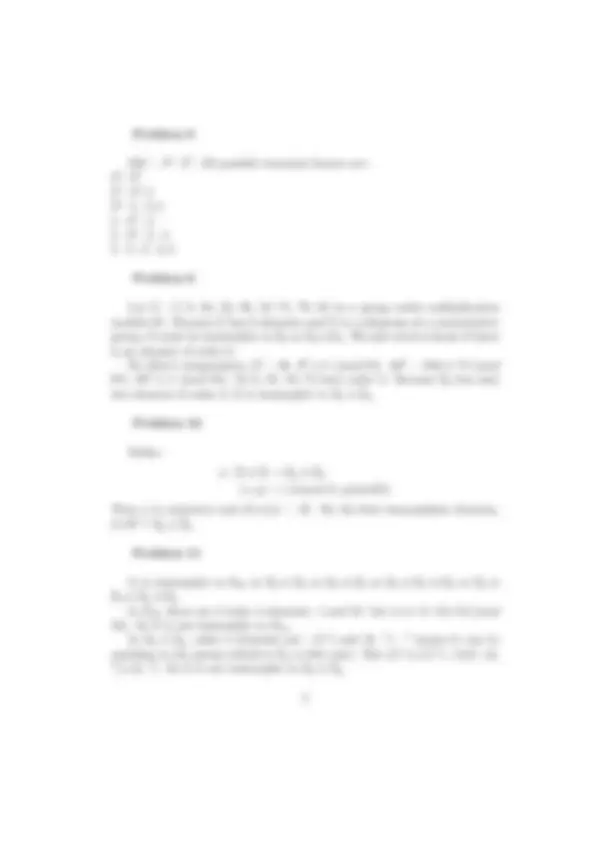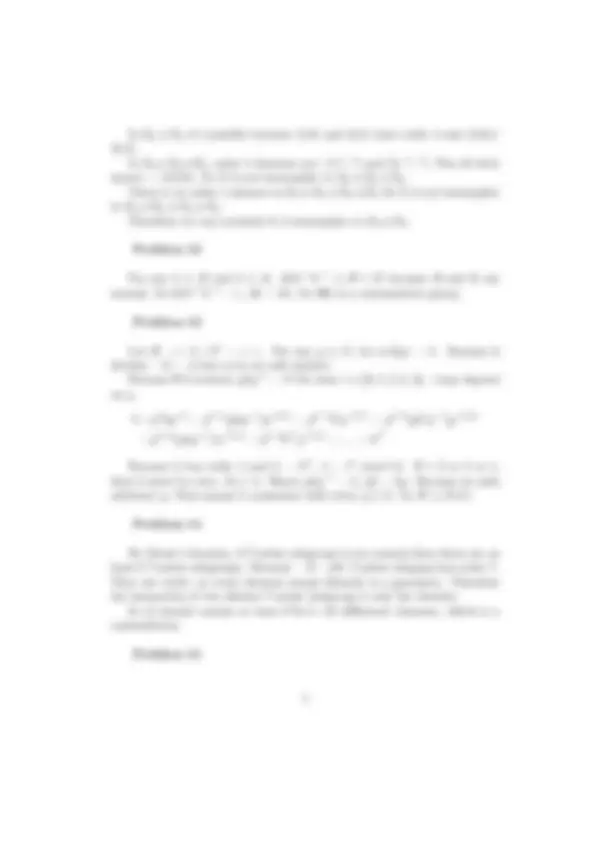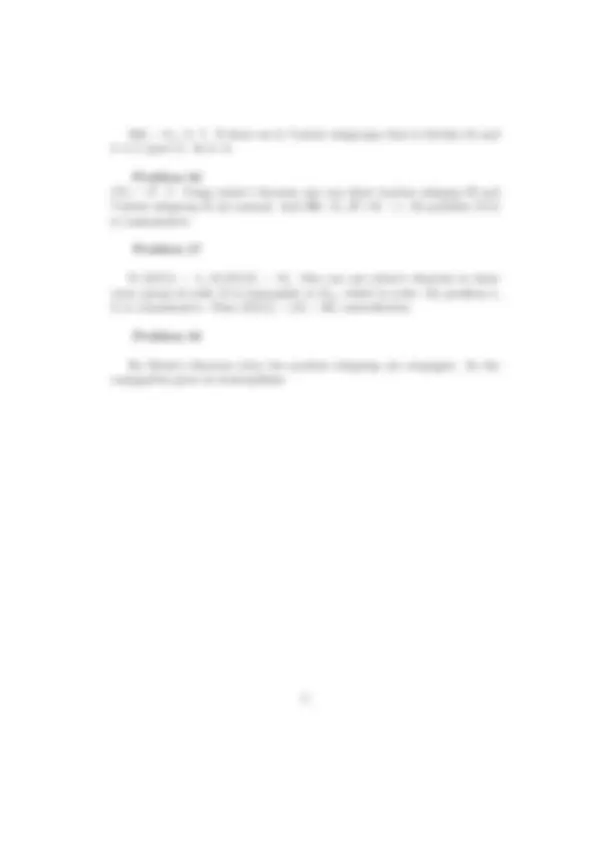





Study with the several resources on Docsity

Earn points by helping other students or get them with a premium plan


Prepare for your exams
Study with the several resources on Docsity

Earn points to download
Earn points by helping other students or get them with a premium plan
Community
Ask the community for help and clear up your study doubts
Discover the best universities in your country according to Docsity users
Free resources
Download our free guides on studying techniques, anxiety management strategies, and thesis advice from Docsity tutors
These are the notes of Exam of Complex Analysis and its key important points are: Not Cyclic, Theorem, Element, Identity, Group Is Commutative, Fourth Element, Prove Directly, Normal, Subgroups, Congruent
Typology: Exams
1 / 5

This page cannot be seen from the preview
Don't miss anything!




Problem 1
(a) True. Because (g 1 , g 2 )(g′ 1 , g 2 ′) = (g 1 g′ 1 , g 2 g′ 2 ) = (g′ 1 g 1 , g′ 2 g 2 ) = (g 1 ′, g′ 2 )(g 1 , g 2 )
(b) False. Z 2 ⊕ Z 2 is not cyclic.
(c) True. It’s by Cauchy’s Theorem (P.96).
(c) False, Z 2 ⊕ Z 2 ⊕ Z 25 does not contain an element of order 4.
(d) True. If there exists one element has order 4 then G ∼= Z 4. If all elements except the identity have order 2, then pick a, b two distinct elements in G, then ab and ba should be the fourth element in G other than a, b, identity. So the group is commutative.
(e) False. S 3 is not commutative.
(f) False. Let H =< (12) > and G = S 3. First you can check H is not normal in G. And prove directly NG(H) = H. So NG(H) is not normal in this example.
(g) True. There is only one such group : Z 17
(h) False. The number of 5-sylow subgroups should be congruent to 1 mod
Problem 2
(a) First we want find the image of 1. Try to solve k to make 7·k = 1 (mod
(b) Ker(φ) = {n ∈ Z 50 | 3 n = 0 (mod 15) } = 5 · Z 50
(c) Image=3 · Z 15 Problem 4
Let G/Z(G) =< x > because G/Z(G) is cyclic. Take ˜x in φ−^1 (x). We can write every element in G as ˜xh, h ∈ Z(G). Randomly pick two elements in G, we can write them as ˜xih 1 and ˜xjh 2 where h 1 , h 2 ∈ Z(G).
˜xi^ h ︸︷︷︸ 1 x˜j h 1 ∈Z(G)
h 2 = x ︸︷︷︸˜i^ x˜j x ˜i^ x˜j^ commutes
h ︸︷︷︸ 1 h 2 h 1 ∈Z(G)
= ˜xj^ ︸︷︷︸˜xih 2 h 2 ∈Z(G)
h 1 = ˜xj^ h 2 x˜ih 1
This implies any two elements in G commutes. So G is a commutative group.
Problem 5
No. Take H =< (123) > and G = S 3. H is cyclic and normal in S 3. S 3 /H has order 2 so it’s isomorphic to Z 2 which is commutative. But S 3 is not commutative.
Problem 6
If we write D 8 = {a, b|a^4 = b^2 = 1, bab−^1 = a−^1 } Define a homomorphism φ : D 8 → Z 2 ⊕ Z 2 by sending aibj^ to (i, j). You can check this is an surjective homomorphism and hte kernel is Z(D 8 ) = a^2 , id. By the first isomorphism theorem, D 8 /Z(D 8 ) ∼= Z 2 ⊕ Z 2
Problem 7
Because 45 = 3^2 · 5, every commutative group of order 45 is isomorphic to Z 45 or Z 3 ⊕ Z 3 ⊕ Z 5. 3 is an element Z 45 of order 15. (0,1,1) is an element in Z 3 ⊕ Z 3 ⊕ Z 5 which has order 15.
In Z 4 ⊕ Z 4 it’s possible because (1,0) and (0,1) have order 4 and (2,0) 6 = (0,2). In Z 4 ⊕ Z 2 ⊕ Z 2 , order 4 elements are: (1,*, *) and (3, *, *). But all their square = (2,0,0). So G is not isomorphic to Z 4 ⊕ Z 2 ⊕ Z 2. There is no order 4 element in Z 2 ⊕ Z 2 ⊕ Z 2 ⊕ Z 2 So G is not isomorphic to Z 2 ⊕ Z 2 ⊕ Z 2 ⊕ Z 2. Therefore we can conclude G is isomorphic to Z 4 ⊕ Z 4.
Problem 12
For any h ∈ H and k ∈ K, hkh−^1 k−^1 ∈ H ∩ K because H and K are normal. So hkh−^1 k−^1 = e, hk = kh. So HK is a commutative group.
Problem 13
Let H =< h | h^5 = e >. For any g ∈ G, let ord(g) = k. Because k divides —G—, k has to be an odd number. Because H is normal, ghg−^1 = hi^ for some i ∈ { 0 , 1 , 2 , 3 , 4 }. i may depend on g.
h =gkhg−k^ = gk−^1 (ghg−^1 )g−k+1^ = gk−^1 hig−k+1^ = gk−^2 (ghig−^1 )g−k+ =gk−^2 (ghg−^1 )ig−k+2^ = gk−^2 hi
2 g−k+2^ =... = hi
k
Because h has order 5 and h = hi k , 1 = ik^ (mod 5). If i=2 or 3 or 4, then k must be even. So i=1. Hence ghg−^1 = h, gh = hg. Because we pick arbitrary g, That means h commutes with every g ∈ G. So H ≤ Z(G).
Problem 14
By Sylow’s theorem, if 7-sylow subgroup is not normal then there are at least 8 7-sylow subgroups. Because —G—¡49, 7-sylow subgoup has order 7. They are cyclic, so every element except ideneity is a generator. Therefore the intesection of two distinct 7-sylow subgroup is only the identity. So G should contain at least 8*6+1=49 differnent elements, which is a contradiction.
Problem 15
168 = 8 ∗ · 3 · 7. If there are k 7-sylow subgroups then k divides 24 and k ≡ 1 (mod 7). So k=8.
Problem 16 175 = 5^2 · 7. Using sylow’s theorem one can show 5-sylow subgoup H and 7-sylow subgroup K are normal. And HK=G, H ∩ K = e. By problem 12 G is commutative.
Problem 17
If |Z(G)| = 4, |G/Z(G)| = 15. One can use sylow’s theorem to show every group of order 15 is isomorphic ro Z 15 , which is cyclic. By problem 4, G is commutative. Then |Z(G)| = |G| = 60, contradiction.
Problem 18
By Sylow’s theorem every two p-sylow subgroup are conjugate. So the conjugation gives an isomorphism.